#perkin warbeck
Text

Henry knew how to play to a crowd, looking down from a window at the mass of penitent rebels in the cathedral close at Exeter in 1497 and then calling out his pardon to them, provoking cries of 'God save the king'. (Steven Gunn)
#warbeck was repelled successively from: 1. kent#2. the north of england; 3. waterford (ireland)#4. exeter#all those times by intervention of the local militia#henry vii#perkin warbeck#historian: nathen amin
29 notes
·
View notes
Text
#wars of the roses#war of the roses#henry vii#perkin warbeck#edward earl of warwick#henry viii#margaret pole#poll
18 notes
·
View notes
Photo



You’d like the crown? This one?
The White Princess | 1.07
#perioddramaedit#periodedit#twpedit#the white princess#thewhiteprincessedit#henryviiedit#henry vii#perkin warbeck#jacobcollinslevyedit#jacob collins levy#*mine
258 notes
·
View notes
Note
Sorry if it's a dumb question. But if people say Lambert or Perkin were the Princes, why did they wait so long to come back?
Richard stole their birthright slurred them their mother and sisters as a whore and bastards. So why the hell did they never appear in his reign and get an army? Yeah it's a short time and they were young but no one's asking them to fight. Plenty of men would've helped.
Like if everyone thought they were dead, Henry's sorta avenging them by killing Richard and marrying Elizabeth. He's the good guy! So why wait.
The best explanation I have is Richard was holding them, and would've kept them in prison until they died, but when Bosworth happened someone let them out.
I mean, if they lived, wouldn't taking two boys hostage, killing protective male family, and never letting them see their mother again, and never have any life at all, be pretty shitty behavior as it is?
So it's kind of a paradox. If Richard didn't kill them, even if they weren't Perkin or Lambert, he was expecting to leave them in jail forever. So he ruined their lives and was cruel for no reason. If he was ready to hurt two children, he sounds like the type of guy who would finish the job and kill them.
So if I follow the whole "they survived" theory through, Richard ends up sounding guilty anyway.
Well, do you know why Lambert Simmel's revolt never happened during Richard III's reign?
Because the rebellion was made by Ricardians.
It's Richard III's sister funding mercenaries led by Richard III's former Lieutenant of Ireland/nephew and his former best friend, landing on Richard III's stronghold and attracting Richard III's former supporters (the Harringtons, Broughtons, Scropes).
Lambert Simmel being Edward V. Makes. No. Damn. Sense.
As for Perkin Warbeck, the fact that he waited years speaks volumes on his authenticity. He was aware that this was an issue, hence his justifications about his brother Edward V being killed by people whom he does not name the sponsor before being put in custody by said killers who seemingly have no trouble killing a 13-year-old but think it's too immoral to kill a 10-year-old. Then they free him after a bunch of years in Flanders.
Two options: either they work for Richard III, in which case they should have no trouble freeing him after he gets killed. Either they work for the Tudors/Tudor-linked, in which case he wouldn't ever be free. What convince me that Perkin Warbeck isn't Richard of Shrewsbury is his own weird version of events, not whatever his opponents said.
And indeed, it's to vindicate Richard III but less as an innocent man than a victim of his time. In the long run, they can't canonize him, considering many of his past deeds. But what they wanna do is pin the portrayal of someone unfairly treated by his contemporaries and posterity. Using a famous mystery in which one can muddy the waters enough to instigate doubts is great for them because then, they can avoid talking about his career as a duke, his actions as a general or his very real ambitions and aspirations.
I do not get their hyperfixation on Richard III & morality. I personally outgrew it when I was 16 years old. Richard III doesn't interest me for that. Their picture of a martyred (?), progressive (??), proto-socialist (???) Duke of Gloucester is so strange it's a bit fascinating.
#Edward V#Richard of Shwresbury#Richard III#war of the roses#Perkin Warbeck#Lambert Simmel#And frankly#if that make them happy to think he didn't do it (TM)#good for them#but what I can't stand is them distorting very clear historical events like the Stoke campaign for their little crusade#I fear some writers/journalists/amateurs/ will even present that as a theory to the wide public when it's bs
14 notes
·
View notes
Text
You know, Perkin Warbeck probably had no true “claim” to the English throne and probably was just a ballsy adventurer, but since monarchy is stupid, I think they should’ve let him be king of England as a treat
Just reward the audacity.
#perkin warbeck#everyone so busy arguing who he was lemme tell you who he was: a man with a stomach of steel#absolutely Wilding yeah whatever go see if you can become king that’d be cool as shit
14 notes
·
View notes
Text
Did Margaret of York try to get Perkin back when he was captured? Did she try to ransom him?
It seems very odd for her to leave her nephew to be hanged without a word of threat or vengeance.
#perkin warbeck#tudor history#henry vii#it's not like james and mary#because james at least demanded compensation
10 notes
·
View notes
Text
The most frustrating part of the Perkin Warbeck story is Prince Richard's sister is RIGHT. THERE. yet there's no record of what she thought about Warbeck's claims.
So you read about how this or that Yorkist was convinced and so people in modern times argue that Perkin must have been Richard because surely his aunt who'd never seen him wouldn't be wrong about something like that? And after a few paragraphs of such "ooh, look at all this support" musings you want to reach back in time and grab someone - anyone! - who was there and yell "JUST TELL ME WHAT THE FUCKING QUEEN THINKS."
Even if she agrees with the modern consensus I'd like to know how she felt about people popping up all the time claiming to be one of her almost-certainly-dead brothers. She's got Warbeck's wife as one of her ladies-in-waiting, is that not really awkward either way?
What did the fucking queen think?!?!
#history fandom#fanwars of the roses#perkin warbeck#not pictured: elizabeth of york (SOMEHOW)#yes i know the answer is “misogyny” but SHE'S HIS FUCKING SISTER WHY DID NOBODY THINK THIS WAS IMPORTANT?!?!#queue
5 notes
·
View notes
Text
Meynnart Wewyck’s workshop-part 6: Hidden in Recueil d'Arras
Sorry guys, I realised this months ago, and forgot to post it. In part 1, I mentioned the lost Scottish portraits by Wewyck, done c.1502-1503. They seem to have been lost, and we only have Receuil d’Arras(collection of drawings based upon actual portraits, done in c.1570) which shows us aproximately how they looked like.
We have drawing of James IV, Margaret Tudor, Henry VII and then very rubbed of Elizabeth of York.
But records from 1502 show one extra painting. Of future Henry VIII. It’d be probably THE oldest portrait of him! As child! But it is nowhere to be found. Or have we been looking at it this whole time?

And if you read further I’ll explain you why this drawing from Receuil D’Arras cannot be the Warbeck. 100%.
This is typical handwriting of Le Boucq, found all over the Receuil d’Arras:

And this is text labelling the drawing of Warbeck as him:

Absolutely no way this is the same hand, and I’d wager not even same century. It’s too readable for modern viewer.
Le Boucq didn’t know who it was. He never made any label for drawing. And let me remind you Le Boucq made the drawing about 70 years after Warbeck died. Cca 1570.
How could anybody even later than that recognize it as Warbeck? Based upon what?! It’s impossible!
It was an unknown male whose portrait was part of Scottish royal collection(that is clear because of drawings surounding it. First 21 drawings in Receuil d’Arras were from(in) Scotland, even though not all sitters of those paintings were. Lots of french and english royalty etc. Royalty often sent each other portraits. Long story short, lots of evidence to suggest it truly was Scottish section.)
And based upon it, somebody GUESSED that it is Warbeck!
It’s supposedly the only depiction of him we have surviving!
And it is not him! 100%.
The jewelry, the posture, it fits with Wewyck’s work and Tudor males so well!
Yes, the features are nicer-because kids tend to have softer features and Le Boucq’s drawings also add the softness(such was his style). It fits perfectly with Wewyck’s work. Just look through previous posts.
Also, how would Warbeck’s portrait survive in Scottish royal collection throughout many years Margaret Tudor was the Queen? She’d be certainly outraged at such display. It’s not make sense for her husband to keep the painting of now dead man of whom he had no use.
Like for Tudors it made sense to portray Richard III with broken sword-because that shows him as warrior who was defeated, thus more glory to Tudors for defeating him.(read my post Mistaken identity, if you don’t get why I assume rest of Richard’s portraits are not him.) But same doesn’t apply to Scottish royalty and Warbeck.
In Receuil d’Arras ‘Warbeck’s’ drawing is not even that far from rest of Wewyck’s work.
It’s Henry VII, then Elizabeth of York, then two drawings of Elizabeth I (from late 1550s it seems), then James IV, Margaret Tudor, then Bernard Stewart, 4th Lord of Aubigny; then drawing of Egyptian woman who once healed Scottish King, James II of Scotland and then supposed drawing of Warbeck.
Henry VIII was just 3 drawings away from his sister, the entire time!
Meaning that probably in c.1570, all those paintings were in same chamber or set of chambers when Le Boucq drawn them. They were not separated, even though by that point nobody could remember who the boy in the painting was.
(Probably because those 4 paintings by Wewyck were in same style. So people knew they belonged together. Just no longer who was in one of them.)
That it is boy might also explain why he is much bigger in current drawing than rest of his family. (or at least Le Boucq makes it seems so.)Some painters struggled with proportions of children, adn then sometimes made them ridiculously smaller or much bigger.Even though Margaret would be in her early teens when she got painted, she’d be still couple of years older than her younger brother, thus her features closer to adults.
(That was main information. If you’re interested into me rambling bit more about the other Scottish paintings by Wewyck you can read further. But to be honest i covered lots of it in part 1. If not I hope you’ve enjoyed this.)
Speaking of Margaret I’d like to clerify something. Records suggest she was painted by Wewyck twice. Once as English Princess, and 2nd time already as Quen of Scotland. Idk which one is in Receuil d’Arras.
1)Drawing of Margaret Tudor, Queen of Scotland, based upon portrait from c.1502-3:

But I belive we have idea how 2nd portrait looked. Family trees of James I show Margaret in en face with gable hood:

It’s also in several engravings. Each of them is of not great quality.
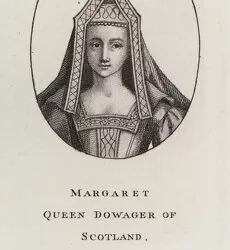
The lenght of frontlets and pitch of gable hood suggest it is early 1500s(max.1505), thus likely based upon Wewyck’s work.
I also wanted to point another thing about these scottish-based portraits. They are unique. While there are other depictions where they hold golden orb/apple? and similiar outfit, together all those details don’t fit any other different versions of their portraits surviving, probably because the copies made during Henry VIII’s reign were made based upon portraits located in England.
Thus Scotish located paintings never had copies of them made. So when alongside many other Scottish portraits they got destroyed, Receuil D’Arras became sole source where we can see them. (As far as we know.)
2)Drawing of Henry VII holding an apple/orb:

(Yep it is once again the same brooch-or perhaps there were 2 of same design but different sizes. But same style brooch.)
While even on Henry VII’s drawing some details of the sleeves rubbed off, note the shape of the oufit around his neck. It is round, and the curve goes downward.
And Henry VIII’s paintings go also downward.
But majority of Henry VII’s paintings, have it other way around. They are pointed upward. And it got me thinking-i don’t much about Tudor male fashion in general. So i don’t know their chronological order. However, around 1480 the neckline of english ladies was curve pointing downward(York sisters stained glass), but then through 1490s we saw W-shaped neckline pointing upward, which then slowly returned to almost straight line with slight raise by c.1500 and eventually to completely straight, only to be curved upward much later towards end of Henry VIII’s reign.
I don’t believe they’d send to Scotland painting predating Henry VII’s reign. It’s 1502 painting. No doubt about it.But neckline of men evolved in same way as ladies’ fashion, then big portrion of Henry VII’s paintings would not be from 1500s, but from 1490s, and I don’t mean just late 1490s. Thus potentially Wewyck worked for English royals for much longer than we assumed.
But I don’t have yet enough to establish firmly chronology of dress and headwear prior to 1500. Sadly my only solid source from that time are tomb brasses and dating of those is very difficult and requires lots of time.
3)Sadly Elizabeth’s sketch is no more there. Sketches are all in pencil and hers sadly got worn out. Only imprint of the original drawing left on the opposite page still survives, but it is really light imprint.@english-history-trip enhanced it a bit(far better than attempt I made and then discarded), but in order to know what that painting looked like, we have to flip it back:

It’s not perfect match with neither of the 5 paintings of her I showed you prior, Currently closest it comes to this:

But why if it is based upon original by Wewyck-from life, why is her neck short?
(In other cases it was in posthumous paintinsg or altered.)
This time there are other possible explanations alterations to the original, le Boucq not gettig proportions right(possibly further shifted by this being based upon imprint) etc. But imo none of those is correct. Imo it’s not alteration. It’s actually there, but isn’t what we think it is(neck crease). Imo it’s edge of necklace.
I had looked at original drawing in Receuil d’Arras, and in Photopea I played with setting to see, if i could find filter or something which would give us better idea of what the drawing looked like. I used both inprint and what is left from original drawing. That is how i discovered that just as Henry she held an orb.
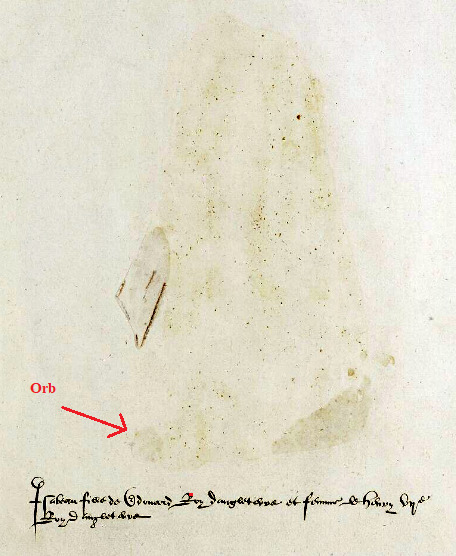
It just stayed on the original page and not on the imprint.
But to get to that necklace, I need to use much stronge filter. Idk what it is called with english, but it turns the drawing into these dots and as you shift the setting, it goes from very dark lines to very light ones-revealing some which you’d never see with naked eye. But it also has downsides. it will hide some lines you’ve seen before and eventually the filter will start to reveal weird lines which are texture of the paper, not related to drawing itself.

Main issue is that some parts are already distorted(because they were visible/more dark before), while some are not, and it is hard to catch the right setting for the era you’re interested in.

However you need to rely on your knowledge of tudor outfit, to connect the dots-literally and to know which dots to not remove.
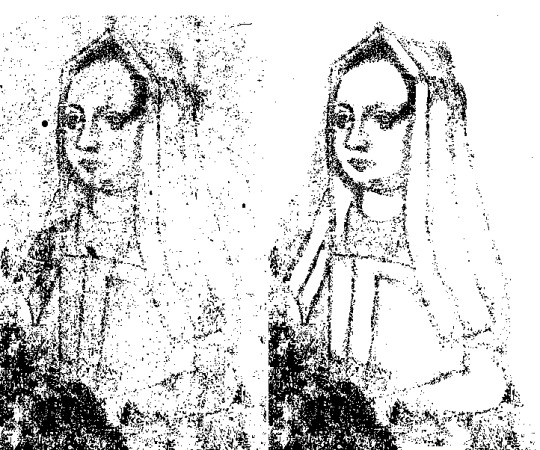
In this setting hands are not visible, but it is focused exactly on the area of clevage. Thus, while rest needs bit of clearing, that area should be fairly accurate. Now I could be wrong, but that looks like necklace to me.
And you can see it on imprint, in HD, if you focus on it. If you search for it. It’s very very light. But it seems to be there.

Tiny bit of pattern, just under the ‘neck crease) which forms shape of triangles I’d say. It’s not likely to be any of the pearl necklace of triangles we seen in late reign of Henry VIII and later. But some late 15th/early 16th century necklaces had similiar form. One is in Receuil d’Arass itself-on Eleanor of Austria as child:
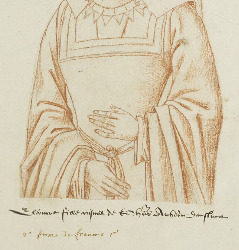
Royalty in those days often had same jewel makers. Just few provided the jewelry of quality royals wanted(that is why often you see same or similiar jewelry across Europe, on members of several different dynasties and it isn’t just them sending each other gifts.) Also fashion and jewelery back then was not solely unique to the country, they influened each other, and some trends took on in several countries or had pararels in them. (Like french hood’s frill and english gable hood’s paste in early 16th century- they moved up and down around same time.)
Thus Elizabeth’s necklace might have looked similiar to Eleanor’s. Idk exact shape, but it seems to me like top same, then much larger triangles. ANd sometimes it seems like two rows of triangles. Idk.
Unfortunately all my attempts looked horrible. You can try it yourself. I give up.

With hadns also. Can’t make the shape out conclusively. And i can’t make the shape out. But it sort of reminds me of necklace of triangles(which obviously was made much later) or some paintings at turn of 15th and 16th century. Nevertheless this is very underated depiction of her.
(I did look into drawing Henry VII also with these filters-because his is also partially rubbed off. He wears his usual clothes he has in many other portraits. There is nothing new for you to learn there.)
I hope you’ve enjoyed this.
7 notes
·
View notes
Text
A Doomed Pretenders Project: An Introduction
Hi!
I've always been slightly hesitant with starting a directly War of the Roses project (despite the excellent ranges of miniatures and example projects to draw inspiration from), partly because I'm never quite sure where to begin with one, and what to use as a 'hook'! I tend to get a bit indecisive over which factions, liveries and time periods to choose. I kept finding myself gravitating towards the pretenders and rebellions in the early Tudor period instead. The potential narrative tropes that can be applied there, like hidden princes and secret conspiracies which lend themselves really well to alternate-history scenarios and definitely captured the imagination!
Using that premise as a base, I've decided to (mostly) split this into three different periods (to correspond to three different pretenders):
- Lambert Simnel, as Edward VI, with the Stoke Field rebellion in 1487
- Perkin Warbeck as Richard IV with his assorted attempts on the throne through the 1490s
- Richard de La Pole, also as Richard IV, with his planned invasions of England under Louis XII and Francis I
This would let me have a fairly wide set of options for figures and conversions to cover the early Tudor period, and a range of different factions I could use to represent the actual (or hypothetical in alternate history scenarios) support given to each of the pretenders over the roughly 40 year period until Pavia!
For a start, I decided to refurb the miniature I painted up to represent Perkin Warbeck, the middlest pretender, back in 2019 as part of my Burgundian project on the Lead Adventure Forum. I wasn't too happy with his old head, so I swapped that out for a new one for the new project!


I've based Perkin Warbeck on this (near) contemporary sketch of him (which happens to look like that one Handsome Superman image), combined with the portraits we have of Edward IV, Richard III and Henry VII:
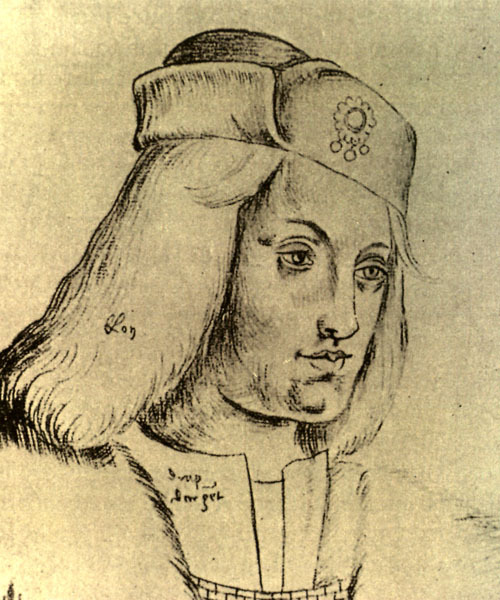
I added little white rose patterns onto his outfit to imply his Yorkist claims, where I thought that if Warbeck was insecure about people believing his claimed identity he would try to compensate by putting Yorkist symbolism all over himself to help convince people.
Another part of starting this project was to have an excuse to paint up some of the Perry WotR Irish range! I really like the figures but didn't really have anywhere to slot them in before, so this seemed like a nice justification! All three pretenders had at least some connection to the Fitzgeralds of either Kildare or Desmond, and even if only Lambert Simnel had any substantial support, it's not too outlandish for either Perkin Warbeck or the de la Pole brothers to field an Irish contingent in an alternate history scenario!

#28mm#28mm historical#doomed pretenders#perkin warbeck#war of the roses#perry miniatures#house of york#15th century#medieval ireland#kern#medieval irish#minipainting#wargaming#28mm wargaming#tudor#tudors
12 notes
·
View notes
Text
I just realized that the actor for Nikolai Lantsov from Shadow and Bone is the same as for Perkin Warbeck in The White Princess.
The "ENGLAND, RECEIVE MY BLOOD" is still something I can't get out of my head.
youtube
4 notes
·
View notes
Note
A big ask I know. But what is some evidence that the documentary conveniently ignored to push their survival narrative?
Evidence of the death of the princes is much less conclusive, because the only contemporary evidence we have are several chroniclers abroad and in England & Wales stating that the princes were murdered or were believed to have been murdered. There is more evidence that Lambert Simnel and Perkin Warbeck were impostors, though. From the top of my head: the Sétubal testimonies confessing Warbeck was not Richard of Shrewsbury, Maximilian I's own 1488 admission to Henry VII claiming he was duped by Margaret of York into backing an impostor (only to do the same again four years later), Perkin Warbeck's letter asking his mother in Tournai for money to pay his expenses in prison in England, and comments by foreign ambassadors who understood the situation was simply international politics.
For more precise scrutinising of the evidence on Lambert Simnel and Perkin Warbeck I really recommend Nathen Amin's Henry VII and the Tudor Pretenders. He never explicitly says his opinion but the evidence he presents clearly points to a logical conclusion.
Now, one truly has to ask why Langley & co decided to discard their earlier Da Vinci code theory that Edward V lived out his days as John Evans in a small Devon village and instead chose to go with the by now often beaten theory that Lambert Simnel was Edward V. It doesn't make sense because those symbols/glass panels were the only genuine new evidence they found (even if imo it's not conclusive to Edward V's survival). The rest was already known since the 1950s.
16 notes
·
View notes
Link
Someone has The Tower of London: The Innocent (BBC 1969) up on YT at the moment. This is available on The Shadow of the Tower dvd release as an extra (or at least, on the Region 2 edition), but I’ve not seen it elsewhere before now.
This was a one-off play about the death of Edward Earl of Warwick, which inspired the PWTB at the Beeb to okay a full series about Henry VII that would also star James Maxwell (evidently impressed with his first go here). That was slightly delayed, but emerged in 1972 as... The Shadow of the Tower! XD
(Episode 12 “The Fledgling” deals with essentially the same plotlines as this one-off effort, but they are not the same.)
It is a very different production, which in itself is interesting to see in the light of what they later came up with! As a one-act play, it’s directed by Jonathan Alwyn, who’s generally good and keeps things moving and (despite the weird mini-selection of cast listed above), it actually stars Robert Powell and Corin Redgrave as Warwick and Perkin, with James Maxwell as Henry VII.
#the shadow of the tower#tower of london: the innocent#1960s#links#period drama#henry vii#perkin warbeck#edward earl of warwick#robert powell#corin redgrave#bernard archard#sott fans will recognise some of the costumes for starters!#it is far more simplistic generally#and henry menaces catherine gordon a bit#but perkin and warwick are still slashy#i would watch or dl asap#these things don't always stay up long!#tudors#(elizabeth of york is not in it i'm afraid)#also the old brit tv actor thing is hilarious#this was the SECOND time in a year that bernard archard and james maxwell locked corin redgrave up in a cell!!
16 notes
·
View notes
Text
Perkin Warbeck besieging Exeter (september 17th, 1497).

Perkin Warbeck attempted to besiege Exeter with Cornish rebels numbering 3,000 to 6,000 men in what is probably the last military operation of the War of the Roses. Against him stand the mayor and municipal authorities with his (alleged) brother-in-law Edward Courtenay, Earl of Devon.
As Perkin Warbeck claimed to be Richard of Shrewsbury, second son of Henry VII, he might have wanted the city as a stronghold, a source of plunder, or a harbor making it easier to escape.
Unfortunately for him, the city and the Earl refused to either surrender or join him. Violent and repeated assaults on the East and northern gate. Without artillery, Perkin's supporters attempted to burn the gate and succeeded. The defenders chose to nourish the fire to block the entry!
Facing the imminent arrival of a royal force, Perkin Warbeck chose to stop attempts to take the city and to move north. At Taunton, he deserted his army at the prospect of facing lord Daubeney's royal army (which was bigger and more equipped). In a letter to the king, Devon wrote that the siege claimed the life or 300 to 400 rebels.
Perkin Warbeck would be captured at Beaulieu Abbey and executed two years later.
#Perkin Warbeck#Henry VII#Edward Courtenay#Earl of Devon#Exeter#I wonder if one could count Perkin Warbeck as part of the War of the Roses#if so this is the last confrontation#1497 could be the end
12 notes
·
View notes
Text
Book Review: “Henry VII and the Tudor Pretenders: Simnel, Warbeck and Warwick” by Nathen Amin
My initial reaction of disbelief to the new ‘revelations’ regarding the Princes in the Tower has not changed, even after viewing the BBC program on US Public TV. In fact, that program was just embarrassing. There is no doubt the documents discovered and viewed are authentic and from the time period in question. Of course, Maximilian provided troops and supplies. Yes, Perkin Warbeck promised the…
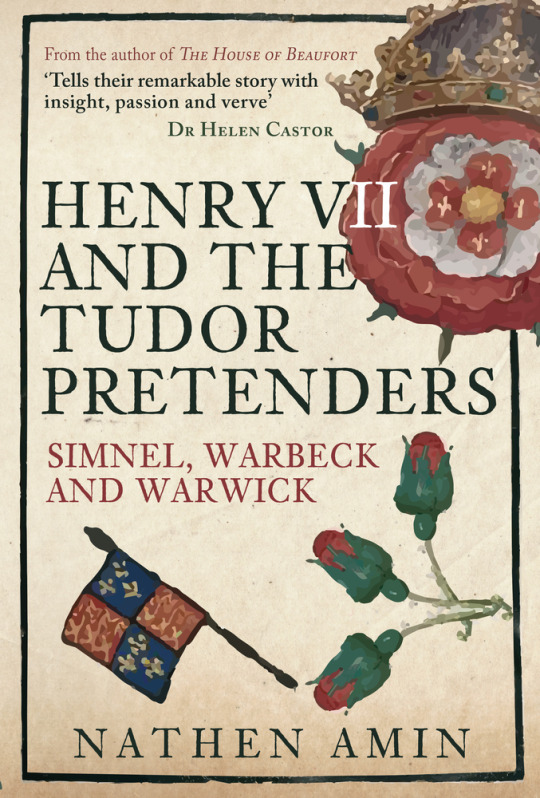
View On WordPress
#book review#books#King of England#Lambert Simnel#medieval history#Nathen Amin#Perkin Warbeck#Pretenders#Tudor dynasty#Tudor History#Wars of the Roses
1 note
·
View note
Text
2 notes
·
View notes
